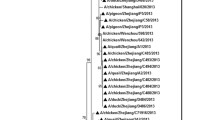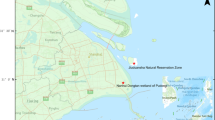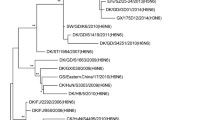Abstract
Live poultry markets (LPM) are one of the most important sources of human infection with avian influenza virus (AIV). During our routine surveillance of AIV, we identified an H9N6 virus (JX-H9N6) in a LPM in Nanchang city, Jiangxi Province, China. Using Bayesian coalescent analysis, it was predicted that JX-H9N6 had originated from a reassortment event between H9N2 and H6N6 AIVs in early 2014, instead of being derived from an H9N6 virus reported previously. Mutations in HA, PB1, PA, M, and NS protein, which could increase mammalian transmission and virulence, were also detected. Currently, both H9N2 and H6N6 AIVs are widely distributed in poultry and contribute to the generation of novel reassortant viruses causing human infection. Our findings highlight the importance of enhanced surveillance in birds for early prediction of human infections.





Similar content being viewed by others
Abbreviations
- JX:
-
Jiangxi Province, China
- LPM:
-
Live poultry market
References
Webster RG, Bean WJ, Gorman OT et al (1992) Evolution and ecology of influenza A viruses. Microbiol Rev 56:152–179. doi:10.1111/j.1541-0420.2008.01180.x
Tong S, Li Y, Rivailler P et al (2012) A distinct lineage of influenza A virus from bats. Proc Natl Acad Sci USA 109:4269–4274. doi:10.1073/pnas.1116200109
Tong S, Zhu X, Li Y et al (2013) New world bats harbor diverse influenza A viruses. PLoS Pathog 9:1–45. doi:10.1371/journal.ppat.1003657
Domingo E, Mas A, Yuste E et al (2001) Virus population dynamics, fitness variations and the control of viral disease: an update. Prog Drug Res 57:77–115
Swayne DE, Radin MJ, Hoepf TM, Slemons RD (2014) Acute renal failure as the cause of death in chickens following intravenous inoculation with avian influenza virus A/chicken/Alabama/7395/75 (H4N8). Avian Dis 38:151–157
Subbarao K, Klimov A, Katz J et al (1998) Characterization of an avian influenza A (H5N1) virus isolated from a child with a fatal respiratory illness. Science (New York, NY) 279:393–396. doi:10.1126/science.279.5349.393
Pan M, Gao R, Lv Q et al (2015) Human infection with a novel highly pathogenic avian influenza A (H5N6) virus: virological and clinical findings. J Infect 72:52–59. doi:10.1016/j.jinf.2015.06.009
Wei SH, Yang JR, Wu HS et al (2013) Human infection with avian influenza A H6N1 virus: an epidemiological analysis. Lancet Respir Med 1:771–778. doi:10.1016/S2213-2600(13)70221-2
Ostrowsky B, Huang A, Terry W et al (2012) Low pathogenic avian influenza A (H7N2) virus infection in immunocompromised adult, New York, USA, 2003. Emerg Infect Dis 18:1128–1131. doi:10.3201/eid1807.111913
Nguyen-Van-Tam JS, Nair P, Acheson P et al (2006) Outbreak of low pathogenicity H7N3 avian influenza in UK, including associated case of human conjunctivitis. Euro Surveill 11(18). http://www.eurosurveillance.org/ViewArticle.aspx?ArticleId=2952
Fouchier RA, Schneeberger PM, Rozendaal FW et al (2004) Avian influenza A virus (H7N7) associated with human conjunctivitis and a fatal case of acute respiratory distress syndrome. Proc Natl Acad Sci USA 101:1356–1361. doi:10.1073/pnas.0308352100
Gao R, Cao B, Hu Y et al (2013) Human infection with a novel avian-origin influenza A (H7N9) virus. N Engl J Med 368:1888–1897. doi:10.1056/NEJMoa1304459
Guo Y, Li J, Cheng X (1999) Discovery of men infected by avian influenza A (H9N2) virus. Zhonghua Shi Yan He Lin Chuang Bing Du Xue Za Zhi 13:105–108
Arzey GG, Kirkland PD, Arzey KE et al (2012) Influenza virus a (H10N7) in chickens and poultry abattoir workers, Australia. Emerg Infect Dis 18:814–816. doi:10.3201/eid1805.111852
Chen H, Yuan H, Gao R et al (2014) Clinical and epidemiological characteristics of a fatal case of avian influenza A H10N8 virus infection: a descriptive study. Lancet (London, England) 383:714–721. doi:10.1016/S0140-6736(14)60111-2
Butt KM, Smith GJD, Chen H et al (2005) Human infection with an avian H9N2 influenza A virus in Hong Kong in 2003. J Clin Microbiol 43:5760–5767. doi:10.1128/JCM.43.11.5760-5767.2005
Xu W, Li H, Jiang L (2016) Human infection with a highly pathogenic avian influenza A (H5N6) virus in Yunnan province, China. Infect Dis 48:477–482. doi:10.3109/23744235.2015.1135253
Shen Y, Ke C, Li Q et al (2016) Novel reassortant avian influenza A (H5N6) viruses in humans, Guangdong, China, 2015. Emerg Infect Dis 22:2015–2017
Zhou B, Donnelly ME, Scholes DT et al (2009) Single-reaction genomic amplification accelerates sequencing and vaccine production for classical and Swine origin human influenza a viruses. J Virol 83:10309–10313. doi:10.1128/JVI.01109-09
Zhang Y, Zou S, Li X et al (2016) Detection of reassortant avian influenza A (H11N9) virus in environmental samples from live poultry markets in China. Infect Dis Poverty 5:4–9. doi:10.1186/s40249-016-0149-2
Zhu W, Li L, Yan Z et al (2015) Dual E627K and D701N mutations in the PB2 protein of A(H7N9) influenza virus increased its virulence in mammalian models. Sci Rep 5:14170. doi:10.1038/srep14170
Reed LJ, Muench H (1938) A simple method of estimating fifty percent endpoints. Am J Hyg 27:493–497. doi:10.1016/j.jvs.2011.05.096
Bouckaert R, Heled J, Kühnert D et al (2014) BEAST 2: a software platform for bayesian evolutionary analysis. PLoS Comput Biol 10:1–6. doi:10.1371/journal.pcbi.1003537
Hasegawa M, Kishino H, Yano T (1985) Dating of the human–ape splitting by a molecular clock of mitochondrial DNA. J Mol Evolut 22:160–174. doi:10.1007/BF02101694
Drummond A, Rambaut A (2007) Tracer v1.5. http://beast.bio.ed.ac.uk/Tracer Accessed 30 Oct 2014
Rambaut A (2009) FigTree, a graphical viewer of phylogenetic trees. Institute of Evolutionary Biology, University of Edinburgh, Edinburgh
(OIE) World Organization for Animal Health (2016) Avian influenza (infection with avian influenza viruses). In: Manual of diagnostic tests and vaccines for terrestrial animals, pp 1–23
Campitelli L, Mogavero E, De Marco MA et al (2004) Interspecies transmission of an H7N3 influenza virus from wild birds to intensively reared domestic poultry in Italy. Virology 323:24–36. doi:10.1016/j.virol.2004.02.015
Matrosovich M, Zhou N, Kawaoka Y, Webster R (1999) The surface glycoproteins of H5 influenza viruses isolated from humans, chickens, and wild aquatic birds have distinguishable properties. J Virol 73:1146–1155
Gabriel G, Dauber B, Wolff T et al (2005) The viral polymerase mediates adaptation of an avian influenza virus to a mammalian host. Proc Natl Acad Sci USA 102:18590–18595. doi:10.1073/pnas.0507415102
Xu C, Hu WB, Xu K et al (2012) Amino acids 473v and 598p of PB1 from an avian-origin influenza A virus contribute to polymerase activity, especially in mammalian cells. J Gen Virol 93:531–540. doi:10.1099/vir.0.036434-0
Xu G, Zhang X, Gao W et al (2016) Prevailing PA mutation K356R in avian influenza H9N2 virus increases mammalian replication and pathogenicity. J Virol 90:8105–8114. doi:10.1128/JVI.00883-16
Fan S, Deng G, Song J et al (2009) Two amino acid residues in the matrix protein M1 contribute to the virulence difference of H5N1 avian influenza viruses in mice. Virology 384:28–32. doi:10.1016/j.virol.2008.11.044
Jiao P, Tian G, Li Y et al (2008) A single-amino-acid substitution in the NS1 protein changes the pathogenicity of H5N1 avian influenza viruses in mice. J Virol 82:1146–1154. doi:10.1128/JVI.01698-07
Lycett SJ, Ward MJ, Lewis FI et al (2009) Detection of mammalian virulence determinants in highly pathogenic avian influenza H5N1 viruses: multivariate analysis of published data. J Virol 83:9901–9910. doi:10.1128/JVI.00608-09
Ciampor F, Bayley PM, Nermut MV et al (1992) Evidence that the amantadine-induced, M2-mediated conversion of influenza A virus hemagglutinin to the low pH conformation occurs in an acidic trans golgi compartment. Virology 188:14–24. doi:10.1016/0042-6822(92)90730-D
Gronesova P, Ficova M, Mizakova A et al (2008) Prevalence of avian influenza viruses, Borrelia garinii, Mycobacterium avium, and Mycobacterium avium subsp. paratuberculosis in waterfowl and terrestrial birds in Slovakia, 2006. Avian Pathol 37:537–543. doi:10.1080/03079450802356953
Perez DR, Lim W, Seiler JP et al (2003) Role of quail in the interspecies transmission of H9 influenza A viruses : molecular changes on HA that correspond to adaptation from ducks to chickens. J Virol 77:3148–3156. doi:10.1128/JVI.77.5.3148
Nomura N, Sakoda Y, Endo M et al (2012) Characterization of avian influenza viruses isolated from domestic ducks in Vietnam in 2009 and 2010. Archiv Virol 157:247–257. doi:10.1007/s00705-011-1152-3
Obenauer JC, Denson J, Mehta PK et al (2006) Large-scale sequence analysis of avian influenza isolates. Science 311:1576–1580. doi:10.1126/science.1121586
Li X, Yang J, Liu B et al (2016) H3N8, and emergence of novel reassortant H3N6 in a local community in Hunan province in China. Sci Rep 6:1–8. doi:10.1038/srep25549
Ma C, Lam TT, Chai Y et al (2015) Emergence and evolution of H10 subtype influenza viruses in poultry in China. J Virol 89:3534–3541. doi:10.1128/JVI.03167-14
Sediri H, Thiele S, Schwalm F et al (2016) PB2 subunit of avian influenza virus subtype H9N2: a pandemic risk factor. J Gen Virol 97:39–48. doi:10.1099/jgv.0.000333
Wang D, Yang L, Gao R et al (2013) Genetic tuning of the novel avian influenza A (H7N9) virus during interspecies transmission, China, 2013. Euro Surveill 19:1–17
Yang Z-Y, Wei C-J, Kong W-P et al (2007) Immunization by avian H5 influenza hemagglutinin mutants with altered receptor binding specificity. Science (New York, NY) 317:825–828. doi:10.1126/science.1135165
Shinya K, Hamm S, Hatta M et al (2004) PB2 amino acid at position 627 affects replicative efficiency, but not cell tropism, of Hong Kong H5N1 influenza A viruses in mice. Virology 320:258–266. doi:10.1016/j.virol.2003.11.030
Xu G, Zhang X, Gao W et al (2016) Prevailing PA mutation K356R in avian influenza H9N2 virus increases mammalian replication and pathogenicity. J Virol 90:8105–8114. doi:10.1128/JVI.00883-16
Acknowledgements
This study was supported by the National Key Research and Development Program of China (2016YFD0500208 to Wang and 2016YFC1200200 to Shu); National Natural Science Foundation of China (81460302 to Chen); The Major Science and Technology Project of Jiangxi Province (20143ACG70004 to Chen).
Author information
Authors and Affiliations
Corresponding authors
Ethics declarations
Funding
This study was funded by the National Key Research and Development Program of China (2016YFD0500208 to Wang and 2016YFC1200200 to Shu); National Natural Science Foundation of China (81460302 to Chen); The Major Science and Technology Project of Jiangxi Province (20143ACG70004 to Chen).
Conflict of interest
We declare that we have no conflicts of interest.
Ethical approval
All applicable international, national, and/or institutional guidelines for the care and use of animals were followed. This article does not contain any studies with human participants performed by any of the authors.
Electronic supplementary material
Below is the link to the electronic supplementary material.
705_2017_3507_MOESM1_ESM.eps
Supplementary material 1 Fig. 1 Evolutionary relationships between the H9N6, H5N6 and H10N6 viruses. JX-H9N6 is indicated by a black triangle, H5N6 strains isolated from humans are indicated by red triangles while other H9N6 strains are indicated by black squares. The phylogenetic tree of the N6 NA gene was generated using the neighbor-joining method with 1000 bootstraps replicates using the MEGA 7.0 software (EPS 2024 kb)
705_2017_3507_MOESM2_ESM.tif
Supplementary material 2 Fig. 2 Yearly distribution of H9N2 strains lacking the potential N-glycosylation site at position 210, 1999–2015 (TIFF 156 kb)
Rights and permissions
About this article
Cite this article
Zhang, H., Liu, M., Zeng, X. et al. Identification of a novel reassortant A (H9N6) virus in live poultry markets in Poyang Lake region, China. Arch Virol 162, 3681–3690 (2017). https://doi.org/10.1007/s00705-017-3507-x
Received:
Accepted:
Published:
Issue Date:
DOI: https://doi.org/10.1007/s00705-017-3507-x




